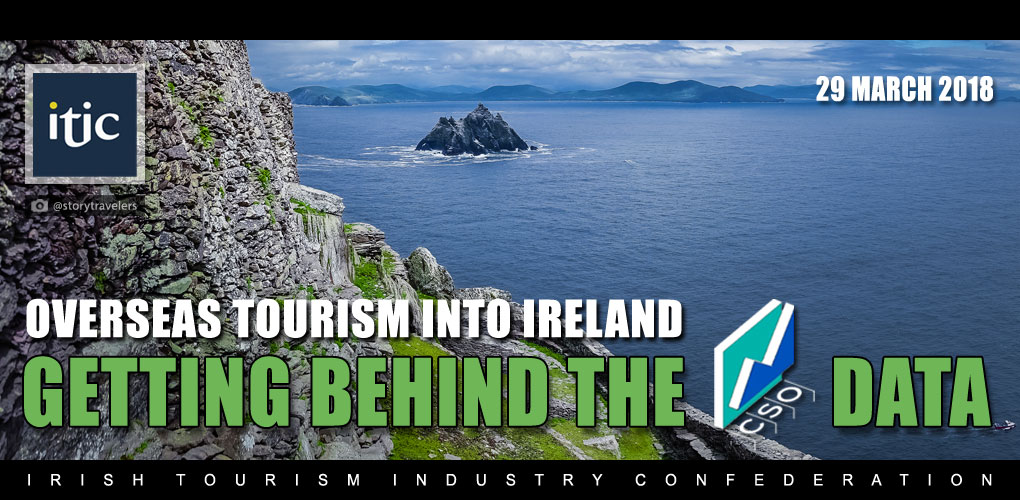
 |
€6.5 billion gross earnings from overseas visitors, including payment to Irish carriers, a 6.5% year on year increase in current terms. |
 |
€4.9 billion spent in the country, up 6.5% in current terms on 2016 levels. |
 |
8.7 million overseas visitors came to Ireland, up 3.5% (excluding day visits) |
 |
300,000 more staying visitors.
|
 |
6.9 nights was the average length of stay, unchanged from 2016 |
 |
68.7 million bednights spent in the country by visitors from overseas,
up 3.5% |
 |
€553 average yield per staying visit, excluding fares paid to Irish carriers,
up 3%
|
 |
Over 1.2 million same day visits, including 785,000 transfer trips at Dublin Airport. |
 |
Almost 92% of visitors arrived by air with their numbers increasing by 4%, while arrivals on ferries dropped marginally by 1%. |
 |
The volume of international visitors who came to Ireland for holiday reasons grew by 8% but business visitors fell by 3%. |
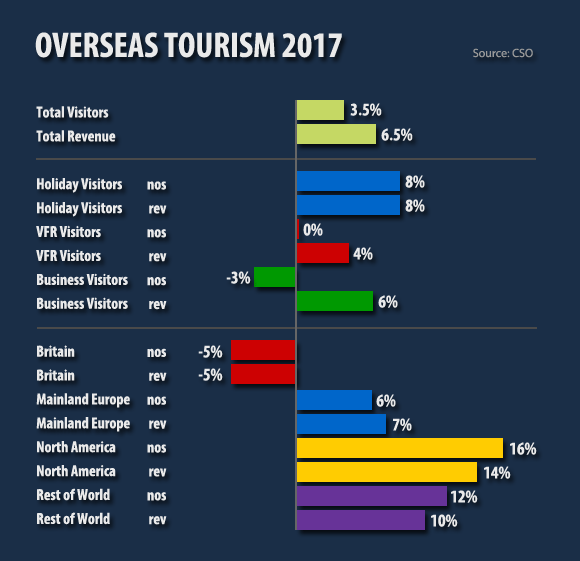
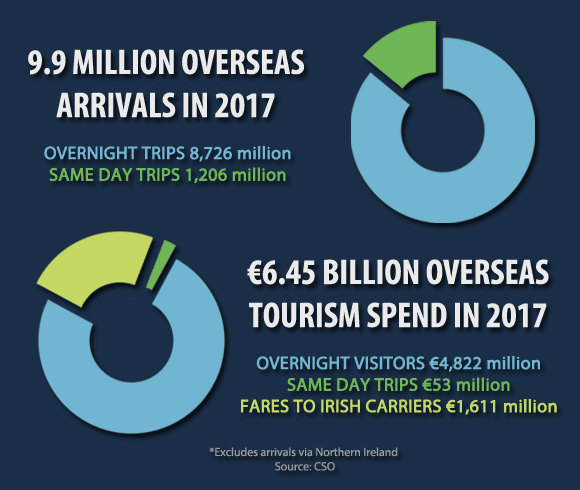

|
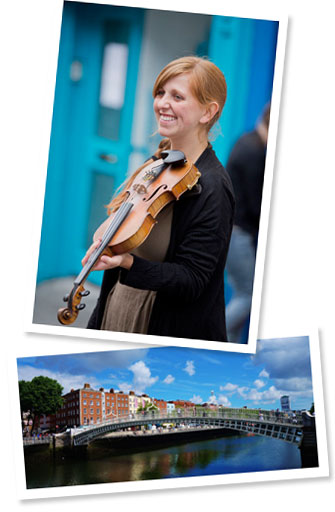
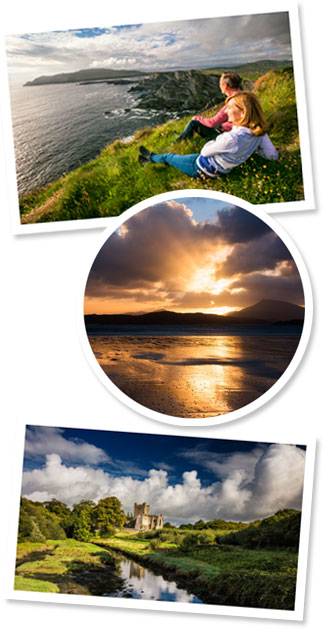
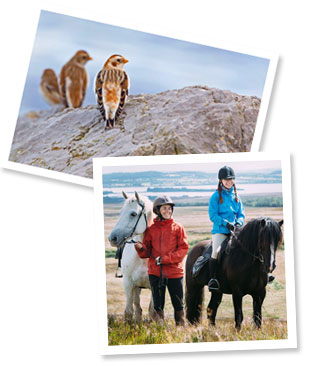
|
 |
Overseas visitor numbers and revenue hit another high in 2017, as global travel continued to grow, with most destinations enjoying a record year in arrivals.
Revenue generated by visitors staying in Ireland topped €4.9 billion for the first time, an increase of 6.5% on the previous year.
The number of arrivals into the country was up 3.6% year on year to a record 9.9 million. Visitors staying overnight - effectively how tourists are defined - reached a new high at 8.7 million, up 3.5% on the previous year. A 7% increase in holiday visits is particularly welcome. There were also 1.2 million day visitors including 785,000 transfer trips through Dublin Airport.
The results for 2017 are characterised by double digit growth from the higher spending long haul visitors, while growth in arrivals from mainland Europe remained robust, and demand from Britain fell.
Ireland, in common with many other destinations, enjoyed the benefits of favourable economic growth and improved consumer confidence in source markets. The exception for Ireland was a dampening of demand from Britain on the back of a weakened currency and Brexit induced uncertainty. The continued expansion of air services on several key routes into Ireland was an invaluable boost to inbound tourism demand.
The 5% drop in volume and value from Britain, while not unexpected, is somewhat worrying as it would appear that Ireland lost share of the outbound British travel market.
The latest CSO data for 2017 - Tourism and Travel Quarter 4 2017 (released March 14, 2018) - provides the basis for a detailed analysis of the demand from overseas which goes beyond monthly visitor head count. The latest quarterly data provides insights into the reason for visit, expenditure patterns and key metrics of length of stay and use of accommodation. The CSO data is based on arrivals into air and sea ports in the Republic, but does not include overseas arrivals via ports in Northern Ireland. The latter will be included in Fáilte Ireland's Tourism Facts 2017 which will be published in due course.
€6.5 billion in earnings from overseas tourists in 2017
Aggregate earnings from foreign tourists to the Irish economy in 2017 were at a record €6.485 billion, represented a 6.5% increase in current terms on 2016.
€4.8 billion was spent in the country by staying visitors plus an estimated €53 million from day visitors, while Irish carriers earned an estimated €1.6 billion from visitors travelling to Ireland.
OVERSEAS VISITORS TO IRELAND 2008 - 2017 |
YEAR |
No. of Visits 000s (1) |
Spend € millions (2) |
Av. spend per visit |
Av. length of stay (nights) |
Av. daily
spend |
2008 |
7,288 |
3,834 |
€526 |
8.1 |
€64.9 |
2009 |
6,470 |
3,410 |
€527 |
7.6 |
€69.3 |
2010 |
5,700 |
2,976 |
€522 |
7.8 |
€66.9 |
2011 |
6,023 |
2,864 |
€475 |
7.7 |
€61.7 |
2012 |
6,039 |
2,882 |
€477 |
7.4 |
€64.5 |
2013 |
6,396 |
3,227 |
€504 |
7.3 |
€69.0 |
2014 |
6,828 |
3,507 |
€514 |
7.2 |
€71.4 |
2015 |
7,749 |
4,169 |
€538 |
7.1 |
€75.8 |
2016 |
8,428 |
4,529 |
€537 |
6.9 |
€77.9 |
2017 |
8,726 |
4,822 |
€553 |
6.9 |
€80.1 |
Source: CSO
Notes: Due to methodological changes there is a slight discontinuity with
pre-2009 data.
(1) - Visits refer to staying at least overnight (excludes arrivals via Northern Ireland)
(2) - Est. spend for staying visitors excludes fares paid to Irish carriers |

|
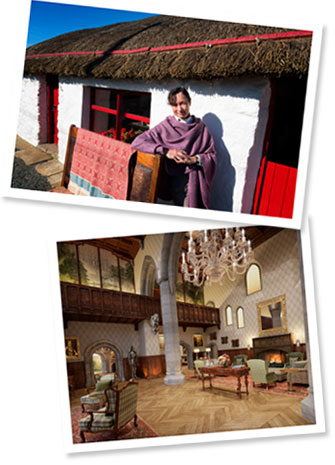
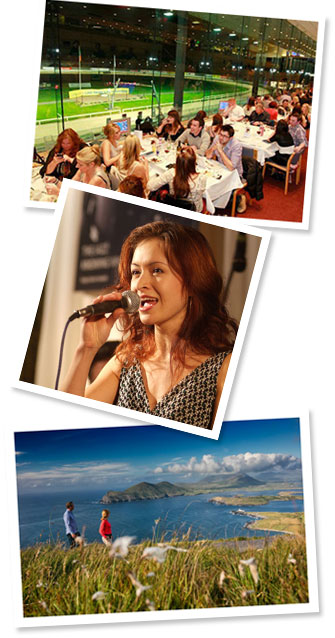
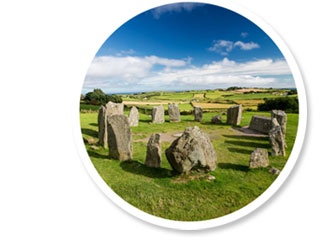
|
 |
The 6.5% year on year increase added €300 million in tourism receipts benefitting businesses throughout the country, albeit that the rate of growth has slowed compared to each of the previous two years.
In value terms continental Europe continues to be the most valuable source market netting €1.77 billion, up 6.6% on the previous year. Visitor spending by North Americans, growing faster than from other markets in recent years helped by a strong dollar, increased by 14% to reach €1.5 billion last year. Spending by visitors from Britain fell in line with a drop in volume demand by 5% to €1 billion. Earnings from visitors from the rest of the world continued to grow in absolute and relative importance with a 10% increase in receipts to €577 million.
€2.76 billion spent in the country by holiday visitors was up 8% on the previous year and accounted for 56% of total earnings. Expenditure by VFR (visiting friends and relatives) visitors increased by 4% to €895m, while spending by business visitors was up 6% to €766 million.
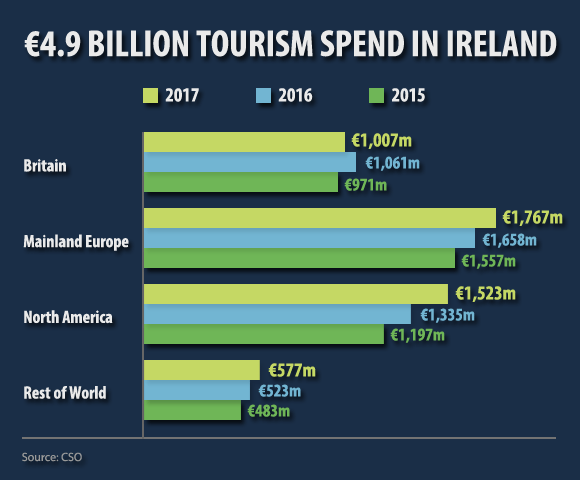
Over the past 5 years annual receipts from North America and from the Rest of the World have each doubled. In contrast, earnings from mainland Europe have increased by 65% and from British visitors by 23% over the same period.
In recent years the return on marketing investment would appear to have been particularly strong from long haul markets which last year accounted for approximately 25% share of visitors but generated 43% of annual receipts.
Average expenditure per visit
The average spend per visit in 2017 is estimated at €553, 3% up on the previous year, reflecting the increasing relative importance of higher spending visitors from North America and further afield. The average spend varies considerably. Holiday/leisure visitor spent an average €585 per visit, which held up well as the volume increased. Business and VFR visitors spend on average €518 and €350 respectively. It would appear that the average expenditure per trip for business visitors increased as average stay increased.
Australians and New Zealanders topped the chart at close to €1,000 per visit, followed by visitors from new emerging long-haul markets spending on average €900. These long haul visitors tend to stay longer, up to an average of 14 nights, thanks to the strong ethnic links with Australia and New Zealand, combined with the upscale profile and expenditure of visitors from the new developing long haul markets particularly in Asia. North American visitors are in third place in the league of trip expenditure spending an average €725 in 2017, marginally down on the previous year as the average length of stay declined from 7.2 to 6.9 nights. Germans continue to be top European spenders with an average trip expenditure in Ireland of €586, while the majority of other Europeans spend close to €500 per visit. British visitors with the shortest average stay in the country spend the least per visit, an average of €270, unchanged from the previous year.
A note of caution may be appropriate as the data is based on sample surveys at point of departure, with the robustness of the data dependent on the accuracy of recall by visitors of their expenditure in the country.
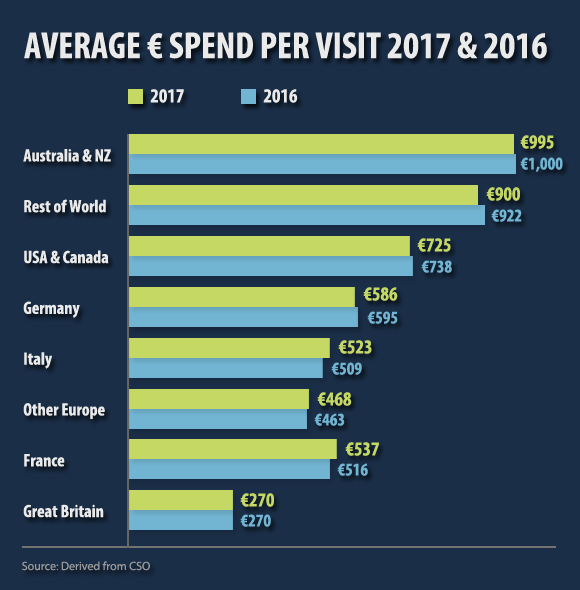

|
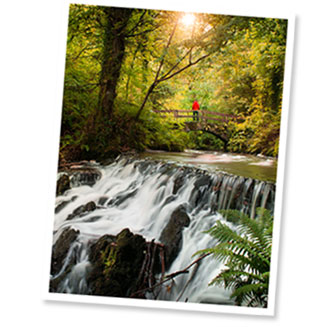
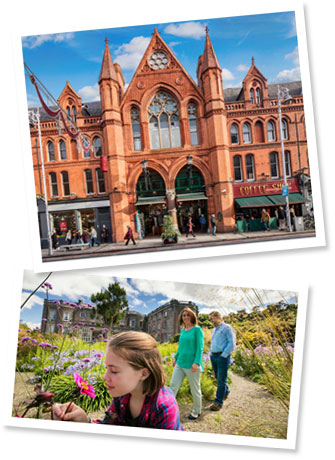

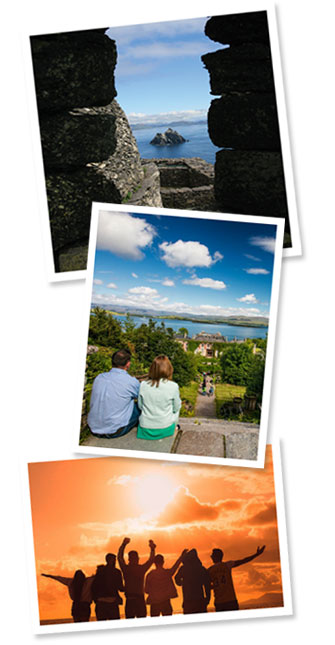
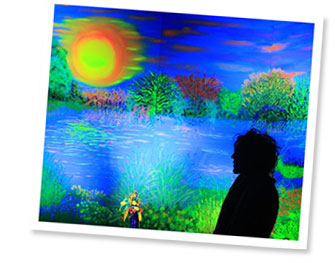
|
 |
4.6 million visitors came for holidays to Ireland in 2017, up 8% on the previous year producing over 300,000 additional arrivals. 2017 was the fifth successive year of growth in holiday visits which account for just over half of all visits.
Visits to friends and relatives (VFR) held steady in 2017 at almost 2.5 million. While VFR trips continue to be an important component of overseas demand their relative importance has been declining in recent years.
Business visits dropped by 3% to 1.27 million in 2017, excluding same day business trips.
Visits for other reasons are estimated to have increased by 3% to 393,000 staying visits.
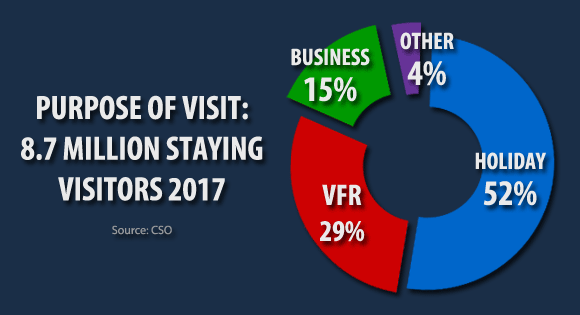

|
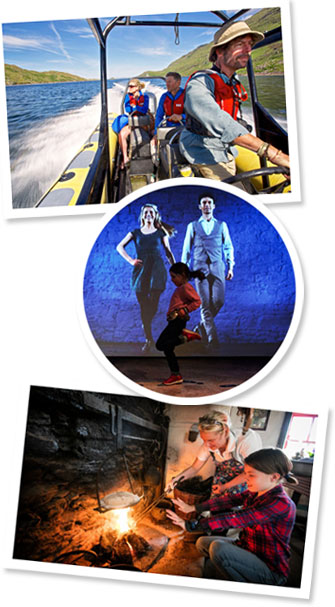
|
 |
Where do holiday visitors come from?
Of the total estimated 4.6 million holiday visitors, Mainland Europe continued to be the largest source with an estimated 1.9 million trips accounting for 41% of the total by volume.
For the first time Ireland welcomed equal numbers of holiday visitors from North America and Britain in 2017 – close to 1.2 million holiday visitors from each market. 6% of holiday visits, at close to 275,000 trips, came from countries beyond Europe and North America.
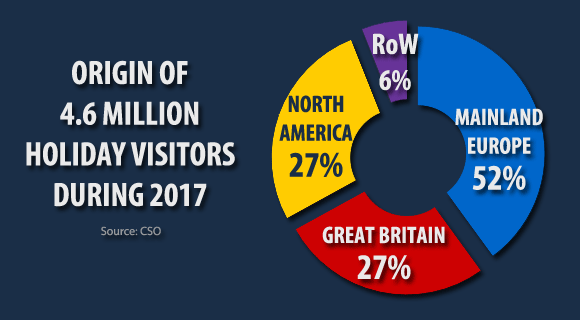
Germany is the top mainland European source market, accounting for 10% of all holiday visits, followed by France the source of 7% of the demand.
The absolute and relative importance of the source markets for holidays in Ireland has changed significantly over the past 10 years. Britain historically the top source market for holiday visitors has been overtaken. Continental Europe, North America and the rest of the world have each increased in importance, in absolute and relative terms, as sources of holiday visitors.
HOLIDAY VISITORS BY SOURCE MARKET
2008, 2014, 2015, 2016 & 2017
|
| |
2008 |
2014 |
2015 |
2016 |
2017 est. |
% change v 2016 |
% change v 2008 |
| Britain |
1,572,000 |
978,000 |
1,172,000 |
1,320,000 |
1,230,000 |
-7% |
-22% |
| M. Europe |
1,196,000 |
1,304,000 |
1,600,000 |
1,700,000 |
1,870,000 |
+10% |
+56% |
| N. America |
596,000 |
783,000 |
900,000 |
1,020,000 |
1,230,000 |
+20% |
+106% |
| RoW |
161,000 |
196,000 |
235,000 |
220,000 |
270,000 |
+23% |
+68% |
| Source: CSO |
Where do VFR visitors come from?
2.5 million visitors came to visit friends or relatives, with more than half come from Britain – an estimated 1.4 million in 2017 or 56% of all visits for this purpose. Mainland Europe has been increasing as a source of VFR demand over the past decade, reflecting migration patterns, and is now the source of 26% of VFR visits, in the region of 650,000 visits last year. An estimated 450,000 visits to friends and relative came from long haul source markets last year.
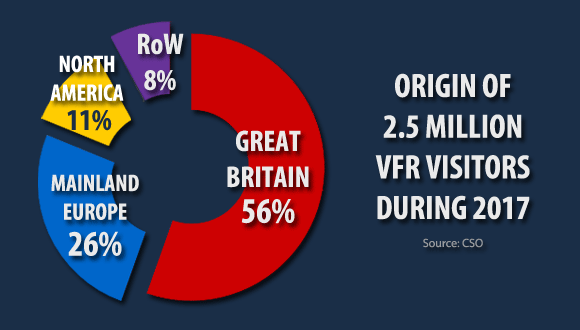
Where do business visitors come from?
Just under 1.3 million business visitors last year – a 3% decline on the previous year. Business visitors from Britain were down by at least 10%, to below 600,000 visits, which suggests a Brexit impact. Business trips from mainland Europe increased in single digits to reach 500,000.
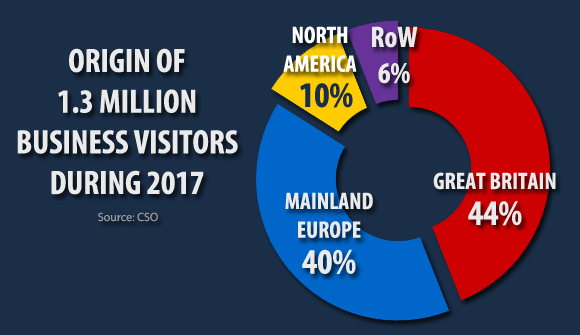

|
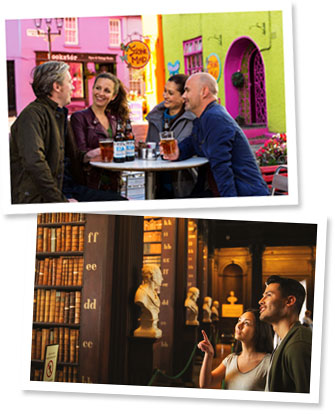
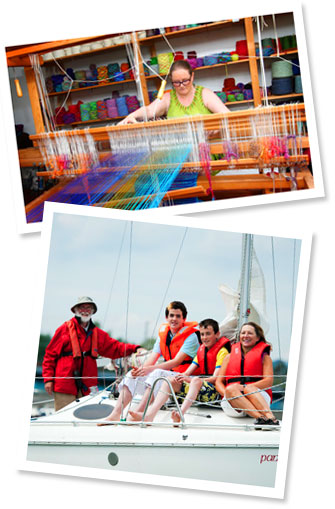
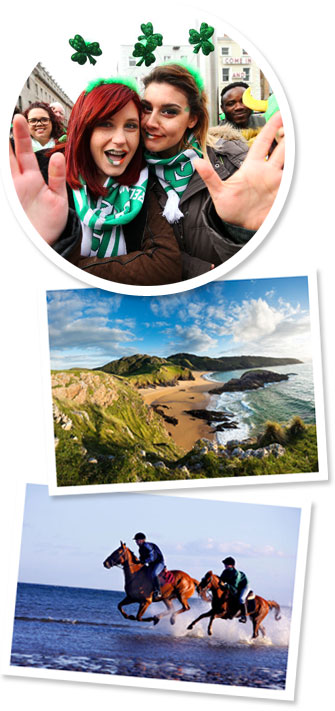
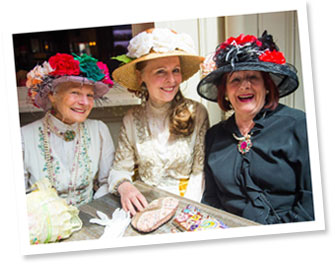
|
 |
Nights in Ireland in 2017 were up 4%, 2.2 million additional nights than in the previous year. The net increase in nights was due to double digit increases from long haul markets more than compensating for lack of growth from mainland Europe and a 12% drop in nights from British visitors.
Mainland European visitors generated 42% of total bednight demand, with almost 29 million nights, while British visitors accounted for 24% at 16.5 million nights, demand from each market almost unchanged. North American visitors generated 14.5 million bednights, up 12%, with visitors from other long-haul markets spending 9 million nights, up 13%, accounting for 21% and 13% share of demand respectively.
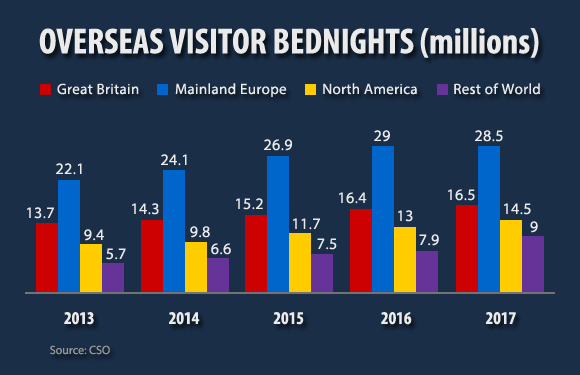
Bednights from holiday visits increased by 7% year on year, with demand from business visitors up 4%, while VFR nights showed no change.
Holiday visitors accounted for an increased share of bed nights at 44%. VFR visits accounted for 27%, with business and those visiting for ‘other reasons’ at 13% and 16% respectively.
Where did they stay?
It would appear that demand for Guesthouse/B&Bs and ‘other accommodations’ categories enjoyed the highest rate of increase in 2017, each up 9%. Bednights spent in hotels increased by 4%, with rented accommodation enjoying a similar rate of increase. Nights spent with friends and relatives, which accounts for 25% of all nights, appear to have been marginally down.
Paid serviced accommodations (Hotels, Guesthouses, and B&Bs) catered to 40% of the demand, while 25% of bednights were spent with friends and relatives. Rented accommodation commanded a 16% share of bednights, with a further 19% spent in ‘other forms of accommodation’. The latter may reflect increased use of Airbnb.
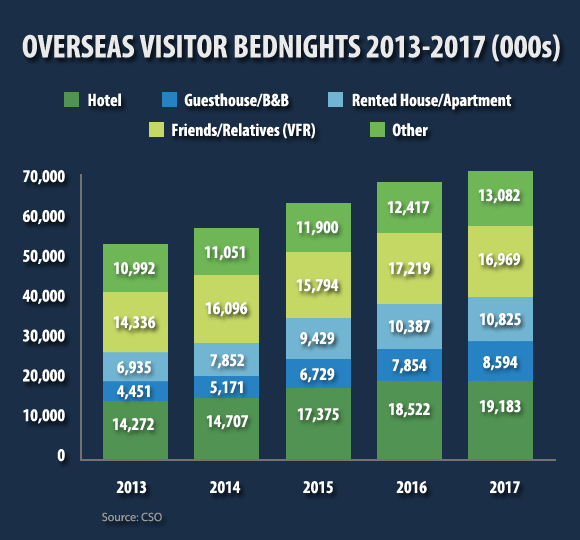
Hotels sold approximately almost 700,000 more bednights to overseas visitors in 2017 than in the previous year, an 4% increase in demand to a total of 19.2 million bed nights. The increase in demand came primarily from holiday visitors, with business guest nights almost unchanged.
Guesthouses and B&Bs catered to an estimated 8.6 million bednights, almost 750,000 more than the previous year. The sector enjoyed a 10% fillip in demand from holiday visitors to over 6 million.
Rented accommodation experienced a 4% increase in the number of bednights from overseas visitors, to reach 10.8 million, spread across most markets and purpose of visit categories.

|
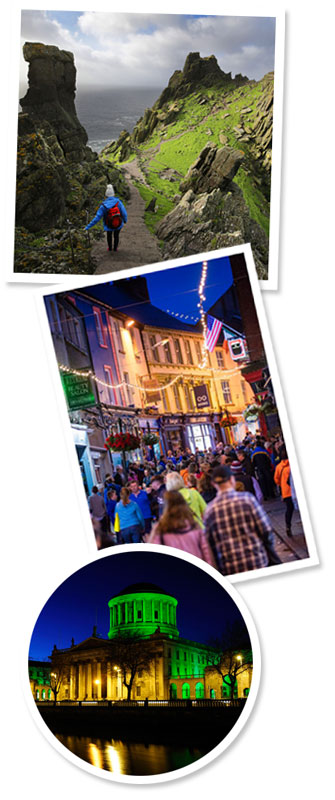
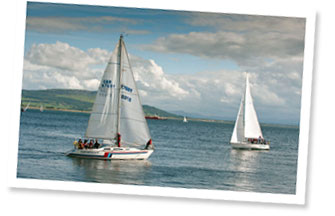
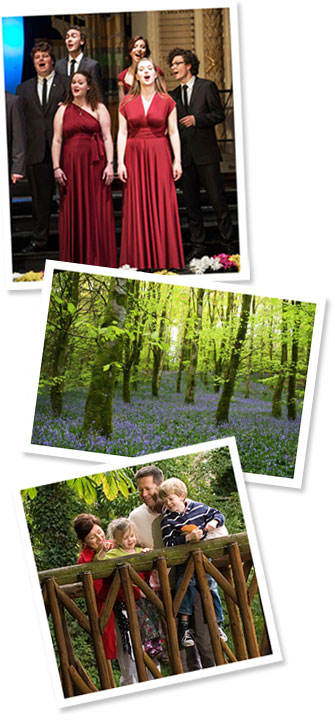
|
Directors:
Maurice Pratt (Chair), Ruth Andrews (Deputy Chair), Adrian Cummins (RAI), Paul Gallagher (IHF),
Declan Kearney (Aer Lingus),
David McCoy (House of Waterford Crystal), Nick Mottram (Irish Ferries),
Cormac O'Connell (daa),
Con Quill (Irish Caravan & Camping Council),
Company Secretary: Eoghan O'Mara Walsh |
© ITIC | Irish
Tourism Industry Confederation | Registered in Dublin | Registered
No: 75658 | All Rights Reserved
Ground Floor, Unit 5, Sandyford Office Park, Dublin 18 | Registered in Dublin Registered No: 75658 |
Tel: +353 (0)1 293 4950 | Email: info@itic.ie | Web: www.itic.ie |
|
|
